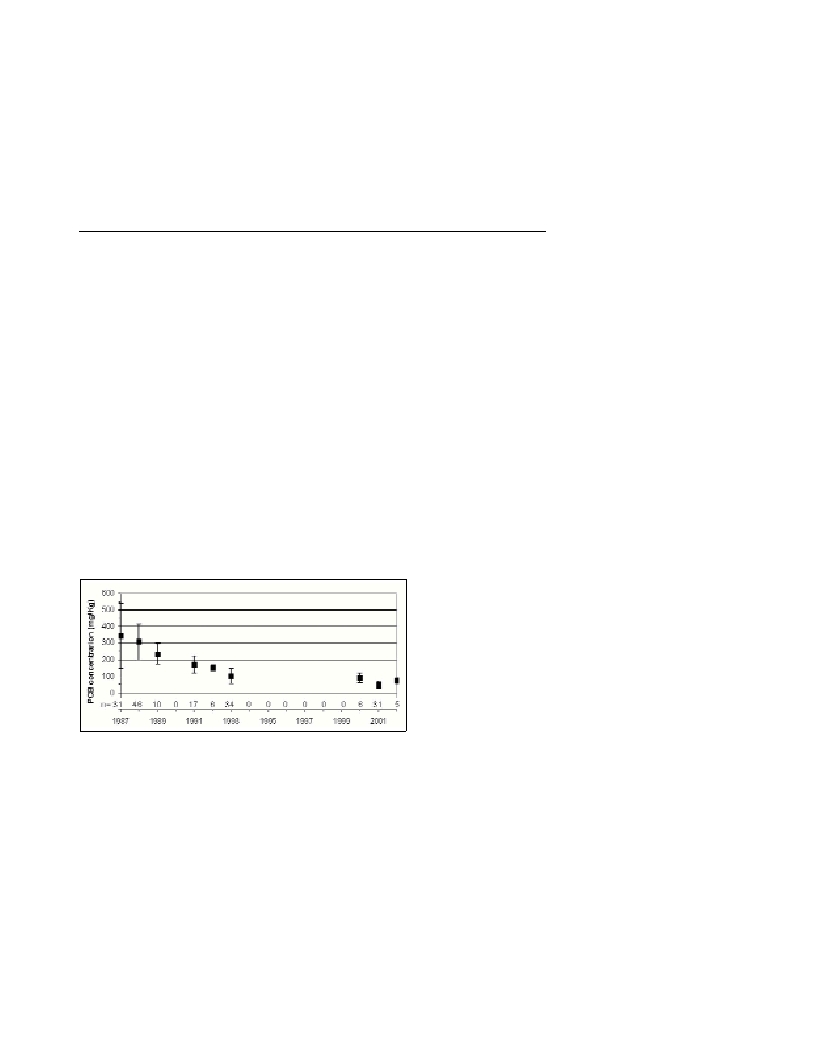PCB TRENDS IN STRIPED DOLPHINS FROM THE WESTERN MEDITERRANEAN SEA
Alex Aguilar* and Asunción Borrell
Dept. of Animal Biology, University of Barcelona, 08071 Barcelona, Spain - * aaguilar@ub.edu
Abstract
The aim of the study was to investigate timetrends in PCB loads in the offshore waters of the western Mediterranean Sea. As bioindicator
we selected the striped dolphin, a long-lived oceanic species, and analysed blubber samples obtained during 1987 2002 from 186
freeranging individuals by means of biopsy techniques. Concentrations of PCBs decreased throughout the period. This decline in oceanic
waters is consistent, albeit not always, with trends observed in coastal surveys. Dolphins and other top predators are thus proposed as
useful indicators to assess long-term trends of pollutants in oceanic ecosystems and large water masses.
Keywords: PCBs, striped dolphin, western Mediterranean Sea, temporal trends, bioindicator
Rapp. Comm. int. Mer Médit., 37,2004
304
Introduction
The use of PCBs was worldwide discontinued in the 1980s but, due
to the stability of these compounds, they have remained as ubiquitous
pollutants in marine environments. PCBs are usually monitored
through coastal organisms and therefore information on offshore
water masses is scarce or nonexistent. Here we investigate the use of
dolphins as bioindicators of PCB pollution in oceanic ecosystems.
Material and methods
Between 1987-2002, with the exception of 1990 and 1994-1999,
we collected blubber samples from 186 striped dolphins in the
offshore waters between mainland Spain and the Balearic Islands. The
tissue was excised from bow-riding dolphins using a biopsy dart (1)
and preserved in deep freeze. Quantification of PCBs was made by
gas chromatography with electron capture detector and SPB 5
capillary column. Data were log-transformed (base 10) and temporal
trends investigated through regression analyses.
Results and conclusions
PCB concentrations (mean=199, SD= 150, in mg PCBs /kg lipid
tissue? ) were of the same order of magnitude as those reported by
previous studies on the same species in north-western Mediterranean
Sea (2, 3), but about 2-10 times higher than those found in other less
polluted water masses (4).
Mean PCB concentrations declined significantly (p<0.0001) from
342 mg/kg in 1987 to 76 mg/kg in 2002 (Fig. 1):
log PCB=112.1-0.0552t (R
2
=0.707, SE (slope)=0.003, SE(intercept)=5.23)
Fig. 1. Mean ±standard deviation of PCB concentrations, expressed as
mg/Kg lipid basis for each sampling year (n= number of samples per
year).
The observed decrease re?ects the reduction of PCB inputs into the
Mediterranean Sea since the 1980s and the subsequent
decomposition/dispersion process undergone by the pollutant. The
European countries bordering the western Mediterranean Sea
manufactured in the past large quantities of PCBs; production in
France, Italy and Spain alone was about 300.000 t during 1954-1984
(5). Since the mid-1980s, PCBs were much restricted though large
quantities remained in uncontrolled disposal sites or were recycled. A
significant fraction of the PCBs released ended up in the sea.
Monitoring of marine ecosystems has been typically made using
widely distributed coastal organisms, such as mussels, other shellfish,
and inshore bottom fish, as bioindicators (5). Although results from
short-term coastal surveys undertaken between the 1970s and the
early 1990s tend to show either stabilization or a decreasing trend in
PCBs (5), data are not consistent (6, 7, 8, 9). Comparable information
on the oceanic water masses is scarce or nonexistent, mostly because
appropriate indicators are not available. Given that organochlorines
are bioaccumulative and magnify through food chains, mobile
–though resident- top predators such as dolphins, porpoises and seals,
have been proposed as indicators (10). Our results show that the
environmental levels of PCBs in the oceanic waters of the Western
Mediterranean have decreased significantly during the last 15 years
and suggest that data from coastal studies, particularly those from
sediments (9), re?ect only local, small-scale processes and may be
non-informative of the long-term, wide-scale variation in the pollutant
loads of large water masses, particularly oceanic.
Acknowledgements. Study funded by the Fundació pel
Desenvolupament Sostenible (FDS) and the DGCONA, Ministerio de
Medio Ambiente of Spain. Samples were supplied by the BMA bank
with the support of the Pew Fellows Program in Marine Conservation
and Earthtrust.
References
1-Aguilar A. and Borrell A., 1994. Assessment of organochlorine
pollutants in cetaceans by means of skin and hypodermic biopsies. Pp.
245-267. In:Fossi, C. and Leoncio C. (eds), Nondestructive Biomarkers
in Vertebrates. Lewis, Boca Raton, FL.
2-Aguilar A., 2000. Population biology, conservation threats, and status
of Mediterranean striped dolphins (Stenella coeruleoalba). J. Cetacean
Res. Manag., 2: 17-26.
3-Marsili, L., Casini, S., Marini, L., Regoli, A., and Focardi, S., 1997.
Age, growth and organochlorines (HCB, DDTS and PCBs) in
Mediterranean striped dolphins Stenella coeruleoalbastranded in 1988-
1994 on the coasts of Italy Mar. Ecol. Prog. Ser., 151: 273-282.
4-O’Shea T. J. and Aguilar, A., 2001.Cetaceans and Sirenians. Pp. 427-
496. In:Shore, R. F. and Rattner B. A. (eds), Ecotoxicology of Wild
Mammals, John Wiley & Sons, Chichester, UK.
5-Tolosa I., Readman J. W., Fowler S. W., Villeneuve J. P., Dachs J.,
Bayona J. M., and Albaiges J., 1997. PCBs in the western Mediterranean.
Temporal trends and mass balance assessment.Deep-Sea Res. II, 44: 907-
928.
6-Villeneuve J. P., Carvalho F. P., Fowler S. W., and Cattini, C., 1999.
Levels and trends of PCBs, chlorinated pesticides and petroleum
hydrocarbons in mussels from the NW Mediterranean coast: comparison
of concentrations in 1973/1974 and 1988/1989. Sci. Total Environ.,
237/238: 57-65.
7-Burns A., Villeneuve J. P., and Fowler S. W., 1985. Fluxes and
residence times of hydrocarbons in the coastal Mediterranean, how
important are the biota? Estuar. Coast. Shelf Sci., 20: 313-330.
8-Solé M., Porte C., Pastor D., and Albaigés, J., 1994. Long-term trends
of polychlorinated biphenyls and organochlorinated pesticides in mussels
from the Western Mediterranean Coast. Chemosphere, 28: 897-903.
9-Tolosa I., Bayona J. M., and Albaigés J., 1995. Spatial and temporal
distribution, ?uxes, and budgets of organochlorinated compounds in
Northwest Mediterranean sediments. Environ. Sci. Technol., 29: 2519-
2527.
10-Aguilar A., Borrell A., and Reijnders P. J. H., 2002. Geographical and
temporal variation in levels of organochlorine contaminants in marine
mammals. Mar. Environ. Res.53: 425-452.

